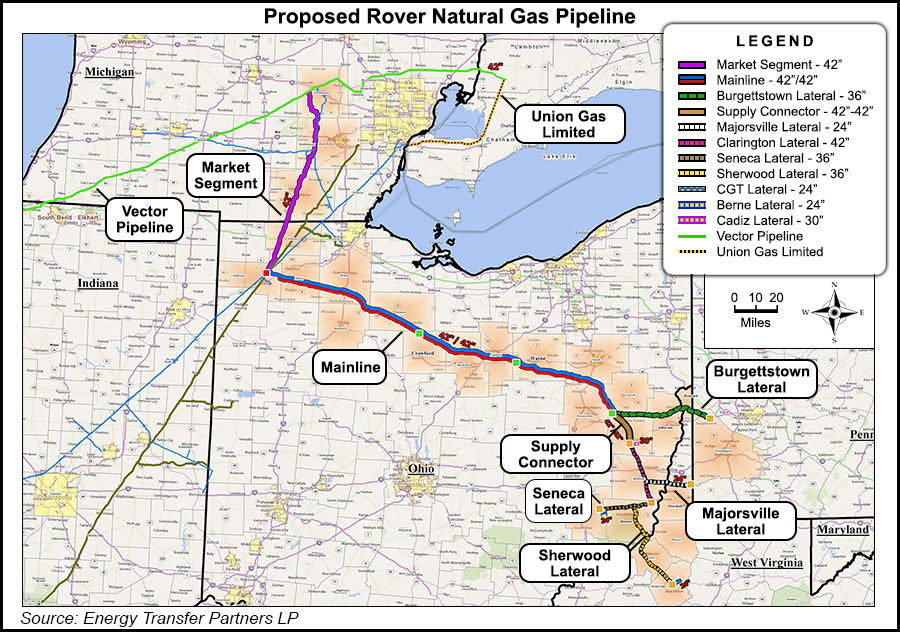Regulatory | Infrastructure | NGI All News Access
FERC Kennels Rover Pipeline’s Request to Finish Creek Crossings in Ohio, West Virginia
FERC has denied giving Rover Pipeline LLC permission to finish horizontal directional drilling (HDD) at two sites critical to laterals in Ohio and West Virginia — at least for now.

Last week, Rover asked to finish HDD crossings of Captina Creek in Belmont County, OH — part of the Clarington Lateral — and Middle Island Creek in Tyler County, WV — part of the Sherwood Lateral.
Federal Energy Regulatory Commission staff on Thursday authorized Rover to “remove the drill stem from the bore-hole at the Middle Island Creek HDD and to install a casing to prevent the hole from collapsing,” while denying the company’s request to continue drilling at the two sites.
FERC wrote that it “will not issue such authorization at this time. Staff has reviewed…Rover Pipeline LLC’s assessment that continued activities would best minimize the environmental impacts and potential extended risks of erosion into sensitive areas. However, field inspections conducted by the Commission’s Compliance Monitors reveal that the sites are currently stable, have appropriate erosion control measures installed, and have drill entry and exit sites adequately set back from the associated waterbody.”
Earlier this month, FERC ordered Rover to stop all new HDD activities for the pipeline pending a third-party review of the company’s handling of a 2 million gallon drilling fluids spill in a wetlands area near the Tuscarawas River in Stark County, OH.
The action came after the Ohio Environmental Protection Agency (OEPA) initiated enforcement proceedings against Rover that could impose more than $400,000 in civil penalties because of the Tuscarawas spill and other alleged environmental violations. The OEPA director urged FERC to intervene, claiming that Rover was challenging the state’s authority to respond to the and the other incidents.
In its May 10 order, FERC expressed “serious concerns” about the scope of the Tuscarawas spill, saying records show a nearly three-week period in which drilling continued even though “returns of drilling mud were absent or intermittent.”
In a letter sent in mid-May to FERC, Rover said it had begun HDD work at the Captina Creek and Middle Island Creek sites and said finishing the crossings would be the most environmentally sensitive option. Rover said it was already nearly two-thirds through the pilot hole at Middle Island Creek and that stopping “could effectively result in additional costs to Rover, which are not justified as Rover is in compliance with its FERC certificate as well as its state and federal permits.”
Rover said it shares FERC’s “general concerns” about the Tuscarawas spill and noted that it has followed its approved HDD contingency plan. The company said it also brought in an HDD engineering firm to help prevent future spills.
However, FERC doesn’t appear to be easing off its order to stop all new HDD work, at least for now. The May 10 order led to speculation about a potential delay, which roiled futures markets given the significant volumes Rover plans to transport once in service. The 3.25 Bcf/d, 710-mile project is designed to connect producing areas of Ohio, Pennsylvania and West Virginia to markets in the Midwest, Gulf Coast and Canada.
Backed by commitments from Marcellus/Utica shale producers, Rover is scheduled to come online in two phases this year. Phase 1, including service to the Midwest Hub in Defiance, OH, is scheduled to start up in July; Phase 2, which includes an interconnect with the Vector Pipeline in Michigan, is scheduled for service in November. Backer Energy Transfer Partners LP has stuck to its original schedule for Rover despite a prolonged FERC review process.
FERC filings indicate halting the Captina and Middle Island creek HDDs would leave the Clarington and Sherwood laterals unfinished.
Genscape Inc. analyst Colette Breshears told NGI recently that with progress on the Captina crossing in limbo, any gathering lines connecting further south on the Clarington Lateral could be impacted.
Without crossing Captina Creek, “Rover won’t have access to any supplies from the Clarington Hub or any receipt points to the west and south of the hub,” she said. “…They’ll have some supply, but they’ll be missing REX, Seneca, Berne, Gulfport, all of their interconnects with Clarington, and they’ll basically only have one good receipt point.”
In a recent conference call to discuss 1Q2017 results, management for Antero Resources Corp., which has 800 MMBtu/d of capacity on the pipeline. indicated the Sherwood Lateral is part of Rover’s Phase 2.
“A number of Utica locations are currently in the process of being completed in anticipation of the Rover Phase 1 start-up,” Antero CEO Paul Rady said. “Once Phase 2 is placed in service connecting [Antero’s] Sherwood facility with Rover, we will likely fill Rover with Marcellus gas while our Utica production continues to grow into the capacity.”
Earlier this week, Rover notified FERC that it has received six proposals from third-party consultants to review the Tuscarawas HDD spill. Rover, required by FERC to solicit the proposals, said they include “sensitive and proprietary information” and asked that they be kept from public review.
The Tuscarawas spill isn’t the first time FERC has scrutinized Rover’s handling of impact mitigation. During the environmental review process, Rover acquired and then demolished a historic home in Ohio that was eligible for preservation without notifying FERC. The home was located near a proposed compressor station, and FERC reviewed the incident as a potential violation of federal historic preservation laws. FERC subsequently denied Rover’s application for a blanket certificate for routine construction activities, an action the company has challenged.
© 2024 Natural Gas Intelligence. All rights reserved.
ISSN © 1532-1231 | ISSN © 2577-9877 |
